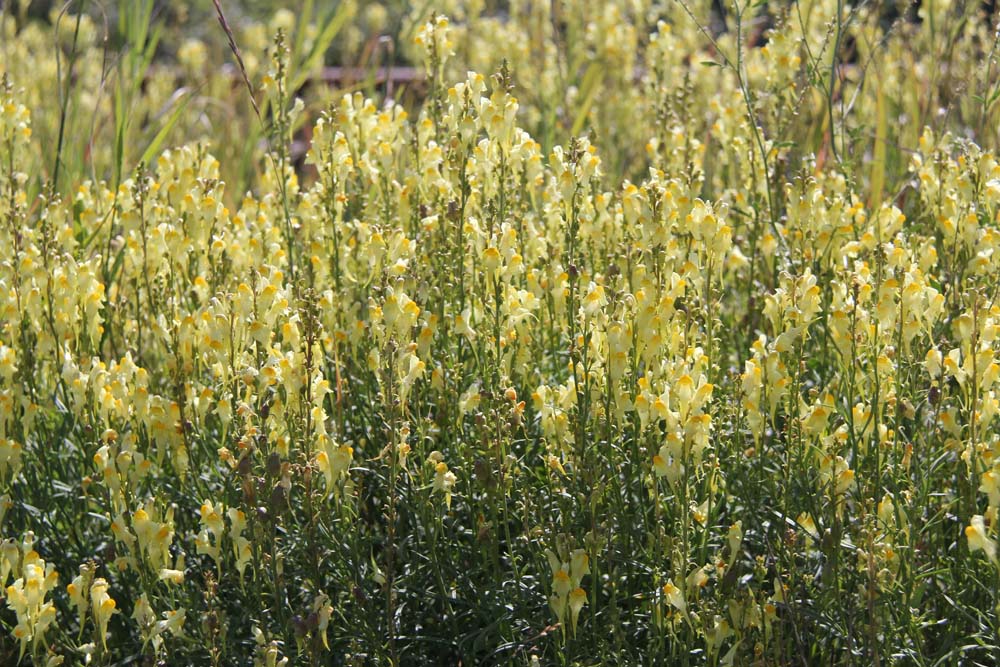Cypress County has many weeds to watch out for: See the expandable tabs below for information on the ones most common in our region.
Baby's breath
Baby’s breath (Gypsophila paniculata)
Baby’s breath is a perennial that reproduces by seed only. It is native to Eastern Europe & western Asia and was likely introduced as an ornamental. It develops a deep tap root that can extend to 4m1 allowing it to access deeper groundwater during periods of drought. The stems die off in winter and new stems sprout from root crown each spring. This is the airy, white flowered plant used extensively by the flower industry as bouquet filler and sold for dried arrangements. In winter stems break off and tumble with the wind, spreading seed – a single plant can produce 1000s of seeds. Baby’s breath is distributed throughout North America – in Alberta it is most common in the drier southern and eastern parts.
Baby’s breath is recognized as a Noxious Weed under the Alberta Weed Control Act, meaning that “A person shall control a noxious weed that is on land the person owns or occupies.”
Baby’s breath (Gypsophila paniculata)
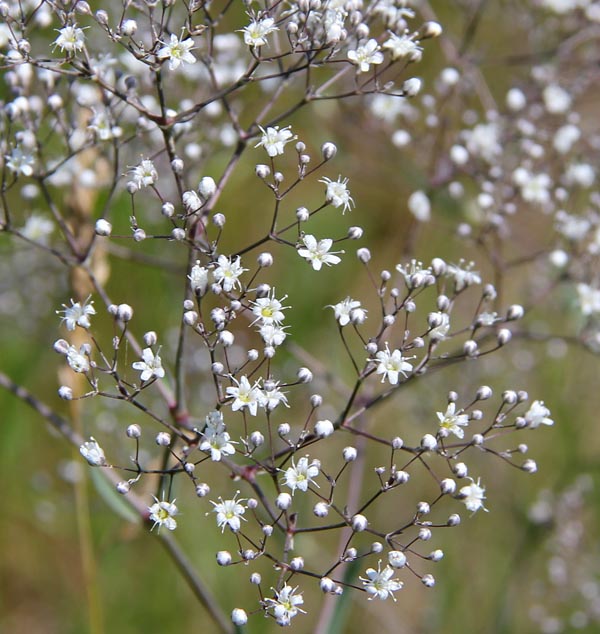 Alberta Weed Act Status: Noxious Weed
Alberta Weed Act Status: Noxious Weed
Distinguishing features:
- Stems are erect, single to many, bluish green, and grow to 0.4 to 1m. They are highly branched near the crown and stems are swollen at the nodes.
- Flowers are white (rarely light pink), have 5 petals, and 6-8mm in diameter. Numerous flowers are borne on short (1-20mm) stalks in highly branched inflorescences. Fruits contain 2 to 5 black seeds.
- Leaves grow from the nodes, are opposite, lance shaped, and 2-9 mm wide. They can be smooth or slightly hairy and occur mainly on the upper parts of stems.
Habitat preferences
- Baby’s breath grows in fine to coarse soils – the tap root grows best in coarse soil – and prefers alkaline soils. It requires full sun and is adapted to arid climates – it is drought tolerant once established.
Prevention:
- Simply do not grow it and dispose of Baby’s breath found in fresh or dried arrangements in landfill bound garbage – many infestations have been found downwind from cemeteries. This plant can invade sandy-soiled hay fields, so baled, infested forage can be a pathway for its spread. Always check wildflower mixes for invasive species before planting.
https://abinvasives.ca/fact-sheet/babys-breath/
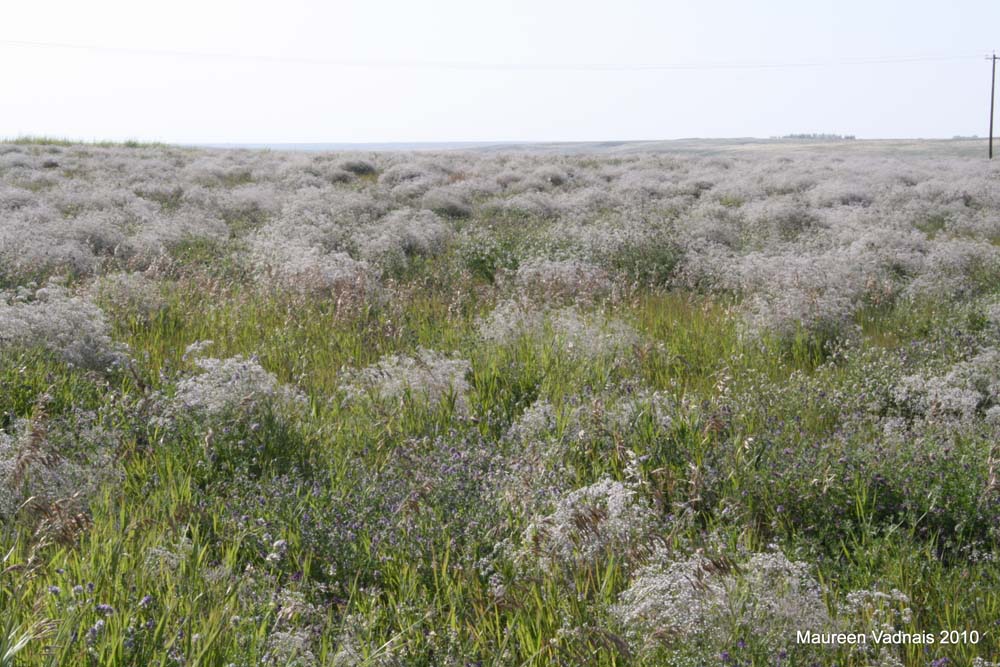
Black henbane
Black henbane (Hyoscyamus niger)
An annual or biennial (forming a rosette the first year) plant that reproduces by seed only. Black henbane was introduced from the Mediterranean and has been used as a medicinal plant since the Middle Ages and was also used in ancient religious rites because of its hallucinogenic properties. It was even used as a flavoring in beer until the Bavarian Purity Law of 1516. All parts of the plant are poisonous to humans and animals when ingested – tissues contain several toxic alkaloids. Symptoms of poisoning include impaired vision, convulsions, coma, and death from heart or respiratory failure. It is a member of the nightshade family and also called “stinking nightshade.” A single plant can produce as much as half a million seeds in 1 season, which are viable for about 4 years.
Black henbane is recognized as a Noxious Weed under the Alberta Weed Control Act, meaning that “A person shall control a noxious weed that is on land the person owns or occupies.”
Black henbane (Hyoscyamus niger)
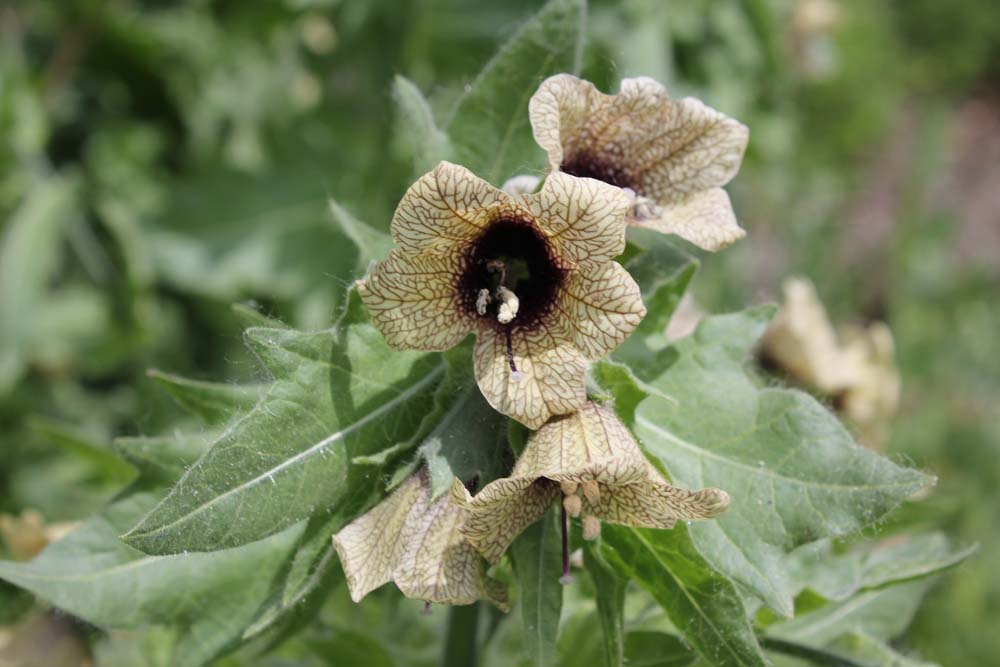 Alberta Weed Act Status: Noxious Weed
Alberta Weed Act Status: Noxious Weed
Distinguishing features:
- Stems are upright, tough – almost woody – and can be very thick.
- Leaves are alternate, large – up to 15 cm wide and 20 cm or more long – and have a heavy, foul scent.
- Flowers are pale yellow with deep purple veins and throats are borne on spikes.
Habitat preferences:
- Black Henbane grows in a wide range of soil textures and pH but does require well drained soil. It does not tolerate the shade.
Control:
- Grazing: Livestock will avoid Black Henbane unless no other forage is available. Dried plant material in baled forage retains its toxic properties and will be readily consumed.
- Mechanical: Mowing is effective, but difficult because of its thick, tough stem. Hand pulling is also effective – be sure to wear gloves and protective clothing to prevent rashes. Care should be taken with mature plants to avoid spreading seed.
https://abinvasives.ca/fact-sheet/black-henbane/
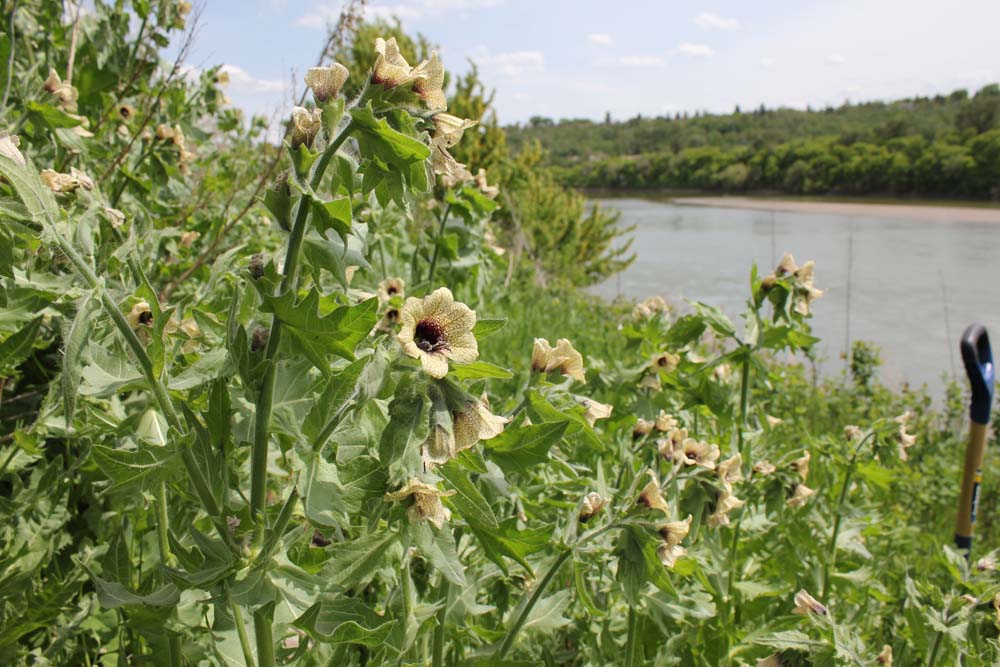
Common mullein
Common mullein (Verbascum thapsus)
Common mullein, a biennial in the figwort family, is native to Asia. It was deliberately introduced to the United States in the 1600s as both a medicinal herb and a fish poison. Historically it has been used to treat a variety of ailments ranging from coughs to earaches. Common mullein naturalized and rapidly spread west after introduction. Currently it is not a weed of cultivated crops. However, it can overtake and displace native species in disturbed areas. It is also thought to serve as an alternate host for insects which can attack apples and pears. Common mullein is a high seed producer. A single plant may develop as many as 240,000 seeds. The seeds have no specialized structures for dispersal so most fall in close proximity to the parent plant. Research has shown that the seeds can remain viable in the soil more than 100 years.
Common mullein is recognized as a Noxious Weed under the Alberta Weed Control Act, meaning that “A person shall control a noxious weed that is on land the person owns or occupies.”
Common mullein (Verbascum thapsus)
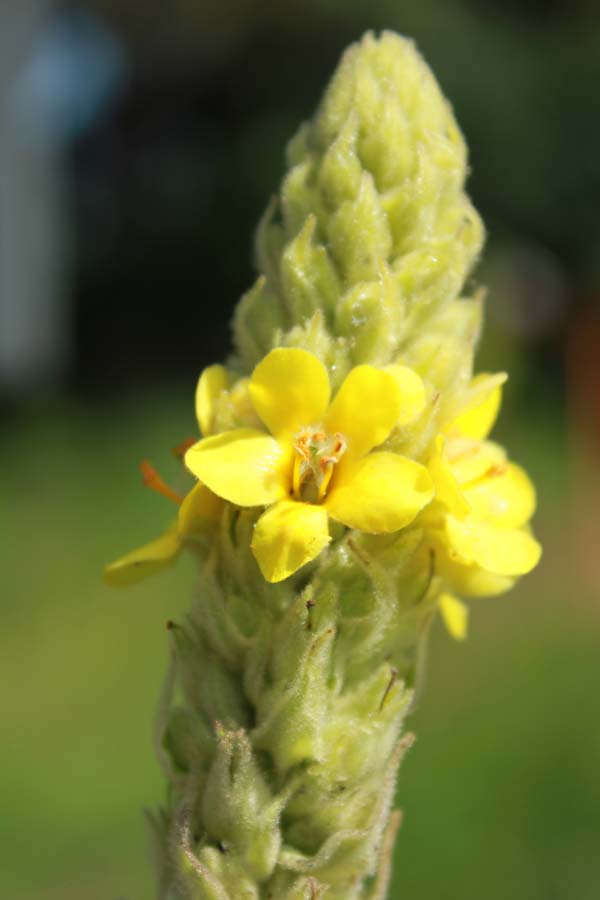 Alberta Weed Act Status: Noxious Weed
Alberta Weed Act Status: Noxious Weed
Distinguishing features:
- Stems are erect, 0.2-0.3 m in height with few to no branches. Stems appear ridged and are densely wooly-hairy. Mature stems from the previous season are brown and often remain standing through the winter.
- Rosette leaves are grey-green 5-40 cm long and wooly-hairy or felt-like. Upper leaves are alternate and smaller (10-30 cm long) with bases that extend down the stem.
- Flowers are bright yellow produced in 20-50 cm spike-like racemes. Individual flowers mature from the bottom to top in a spiral pattern.
Habitat preferences:
- A colonizing species, Common Mullein will readily establish in disturbed areas with well-drained, sandy or gravely soils. It is frequently found along roadsides, rights-of-way and waste areas.
Control:
- Cultural: Seeding bare ground with early successional native grasses and forbs will decrease the establishment of common mullein on disturbed sites,
- Mechanical: Where feasible, tillage provides good control of Common Mullein rosettes. Mowing is less effective since the rosettes will continue to develop after cutting. Once mowing ceases, the plants will produce axillary branches that can flower later.
https://abinvasives.ca/fact-sheet/mullein-common/
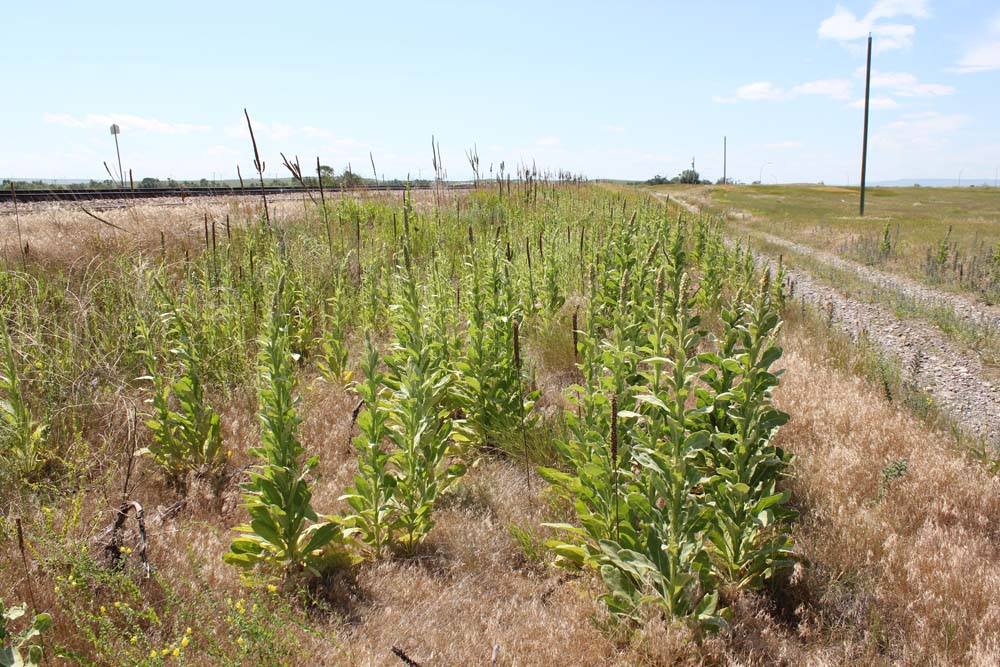
Dalmation toadflax
Dalmation toadflax (Linaria dalmatica)
Native to the Mediterranean, Dalmation toadflax was introduced to North America sometime around 1900, possibly as an ornamental. It is a short-lived perennial that reproduces both by seed and creeping roots. First year plants develop a rosette of leaves and a deep root system. The main taproot may grow over 1 m deep and lateral rhizomes can extend more than 3 m – buds on lateral roots form new stems. Stems and leaves of the plant are bluish-green, smooth, and waxy. Flowers are nearly identical to those of Common/Yellow toadflax, except the flowers of Dalmation are larger.
Dalmation toadflax is recognized as a Noxious Weed under the Alberta Weed Control Act, meaning that “A person shall control a noxious weed that is on land the person owns or occupies.”
Dalmation toadflax (Linaria dalmatica)
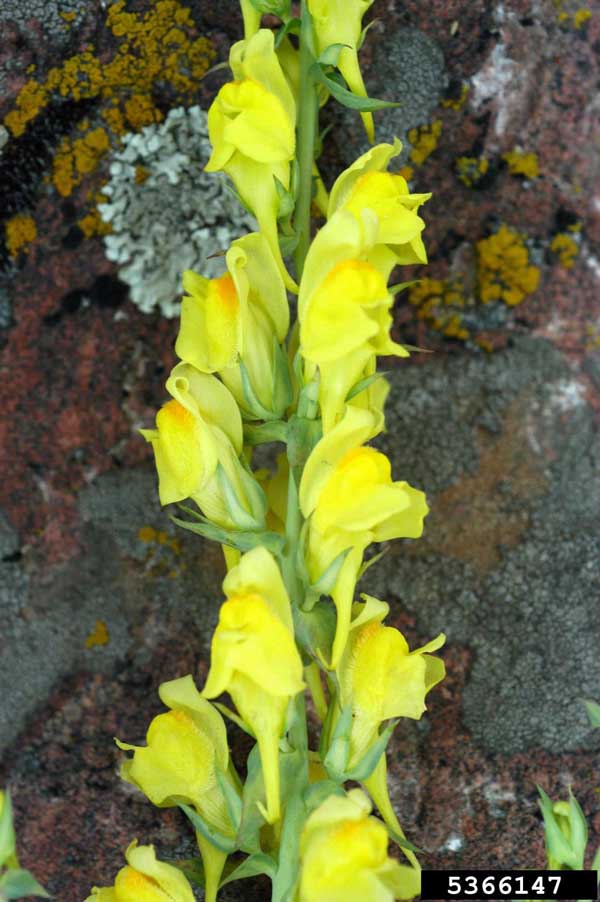 Alberta Weed Act Status: Noxious Weed
Alberta Weed Act Status: Noxious Weed
Distinguishing features:
- Stems are erect and grow to 1 m tall with some branching in the upper part. There may be one to many floral stems per plant.
- Leaves are broad and heart-shaped with a pointed tip and clasp the stem. They are arranged alternately and are crowded on the lower stem.
- Flowers are bright yellow with a darker yellow spot on the lower lip and are borne on the upper branches of stems. They resemble snapdragon flowers and can be up to 3.5 cm long, including the spur extending from the base.
Habitat preferences:
- Dalmation Toadflax grows best in full sun and coarse textured, well-drained soils that are pH neutral to slightly alkaline. It is usually found low-mid elevations that are sheltered and/or have southern exposure.
Control:
- Grazing: Dalmation Toadflax contains compounds toxic to livestock, since the plant is unpalatable poisonings are rare.
- Cultivation: Intense repeated cultivation in crop situations for at least 2 years.
- Mechanical: Mowing and hand pulling before flowering will prevent seed production, but re-sprouting will occur. Repeated hand pulling in loose soils, getting as much root as possible, and repeated for a few years can control/eradicate small infestations.
https://abinvasives.ca/fact-sheet/toadflax-dalmation/
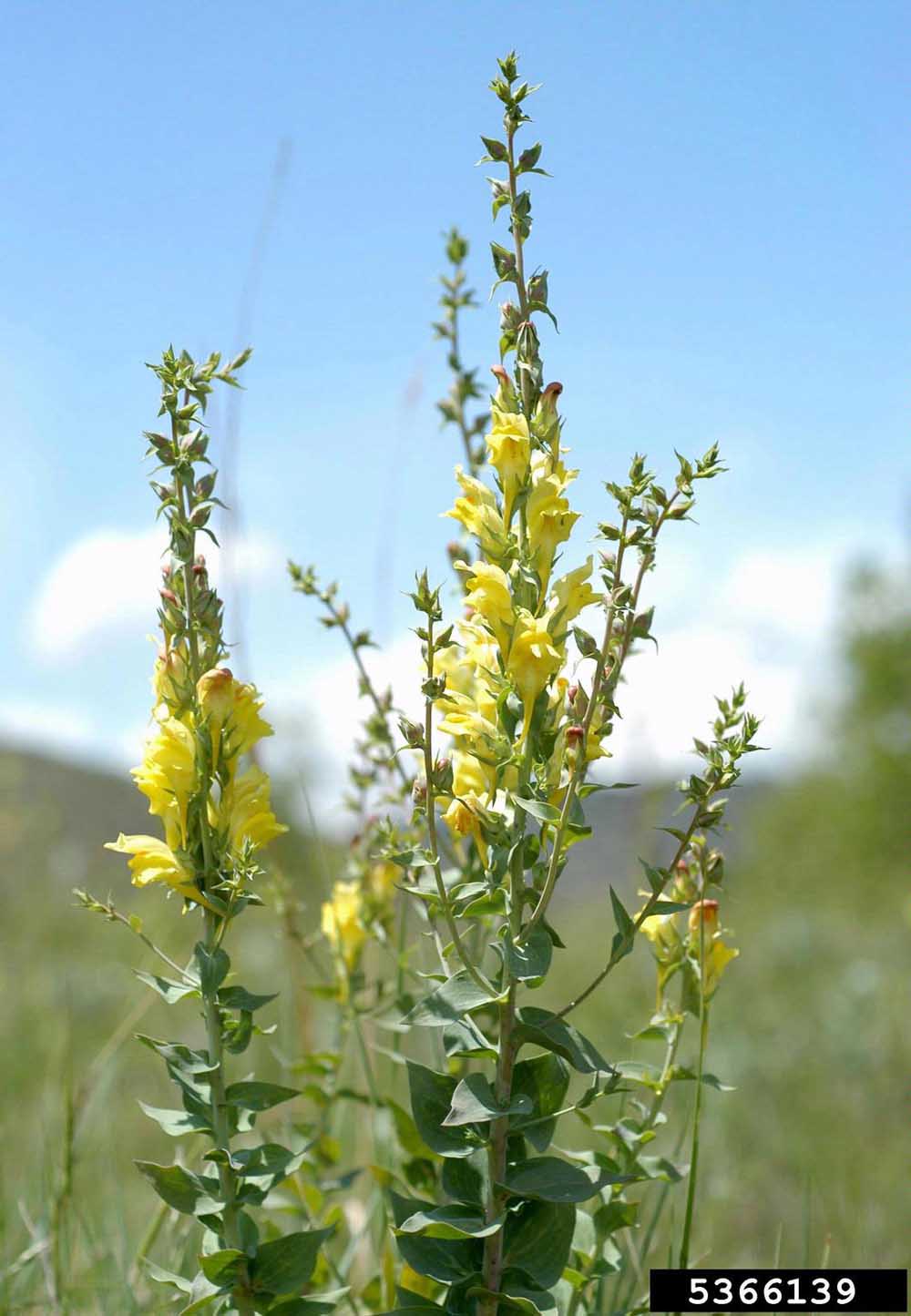
Dame's rocket
Dame’s rocket (Herperis matronalis)
Dame’s rocket is a biennial or short-lived perennial native to Europe and southwest Asia. A member of the mustard family, it is a prolific seed producer. The flowers are very fragrant especially in the evening – and are insect pollinated. Introduced as an ornamental, it has spread throughout North America, except for the driest areas.
Dame’s rocket produces a rosette in the first year of growth and then a flowering bolt in the second year. It blooms early summer; stems wither and die by late summer.
Dame’s rocket is recognized as a Noxious Weed under the Alberta Weed Control Act, meaning that “A person shall control a noxious weed that is on land the person owns or occupies.”
Dame’s rocket (Herperis matronalis)
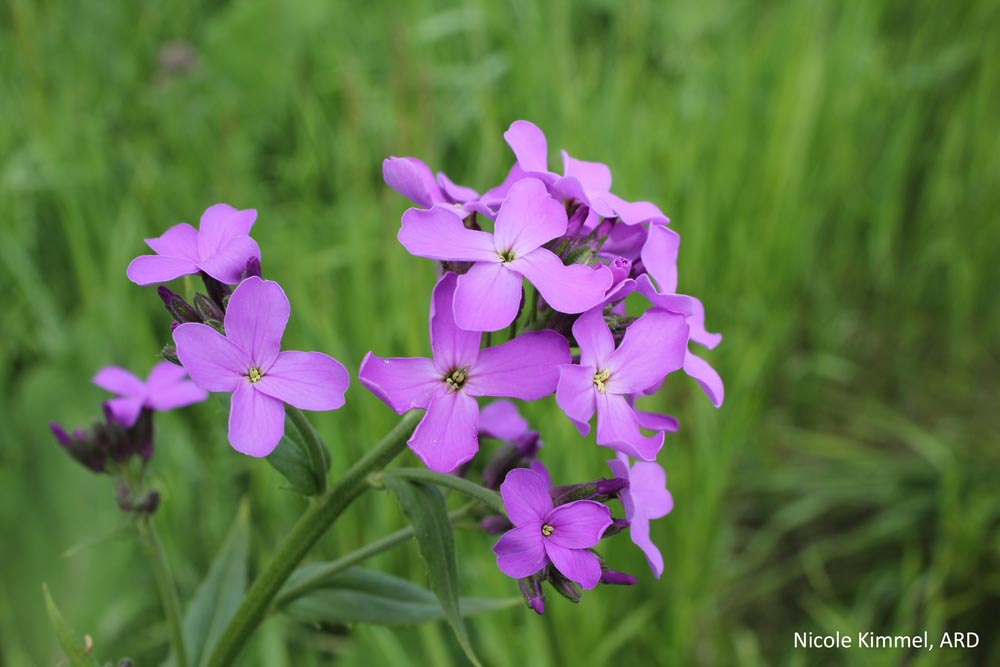 Alberta Weed Act Status: Noxious Weed
Alberta Weed Act Status: Noxious Weed
Distinguishing features:
- Stems are erect, several per plant, and grow 0.5 to 1 m tall, occasionally taller.
- Leaves are alternate, lance-shaped and are 1-4 cm wide and 4-15 cm long. They are dark green, hairy on both sides, and have serrated edges.
- Flowers can be white, lavender-pink or purple and are 8-12 mm wide with 4 petals. Flowers are borne in loose clusters at tops of stems.
Prevention:
- Dame’s Rocket is often a contaminant of wildflower seed mixes – do not purchase seed mixes which do not list the Latin names of the contents.
Control:
- Mechanical: Hand-pulling is considered the most effective as the roots come out easily from moist soils, or can easily be dug out with a shovel. Plant density may increase the year following control work due to disturbance, but repeated removal will exhaust the seed bank.
https://abinvasives.ca/fact-sheet/dames-rocket/
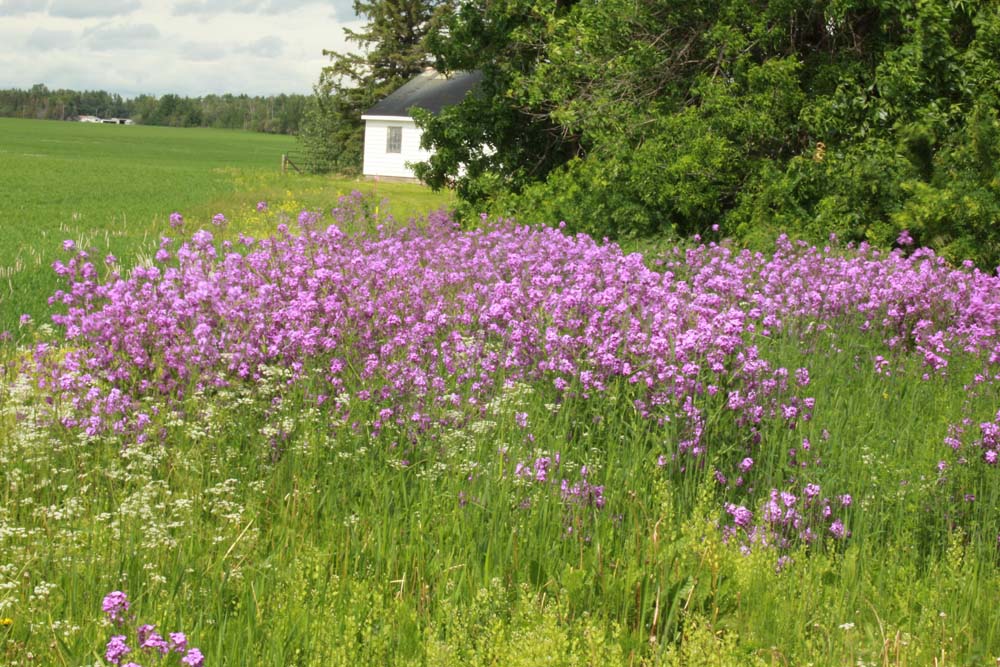
Diffuse knapweed
Diffuse knapweed (Centaurea diffusa)
A biennial to short-lived perennial that reproduces by seed. Seeds germinate in the fall or spring and develop low lying rosettes in the first year of growth. It is a highly competitive plant that establishes quickly on disturbed sites and can also invade undisturbed plant communities. A single plant can produce 18,000 seeds. Diffuse knapweed is an extremely tough plant that can tolerate drought, trampling, and very rocky soils. Its roots exude a chemical that inhibits the root growth of other plants. Knapweeds have become well known because of their almost wholesale degradation of large tracts of rangeland in the northwestern US and parts of southern BC. In winter, plant skeletons break off and tumble in the wind, spreading seed. Diffuse knapweed can sometimes be confused with spotted knapweed, which sometimes has white-pink flowers, but Diffuse plants are shorter, stiffer, prickly and more of a grey-green.
Diffuse knapweed is recognized as a Prohibited Noxious Weed under the Alberta Weed Control Act, meaning that “A person shall destroy a prohibited noxious weed that is on land the person owns or occupies.”
Diffuse knapweed (Centaurea diffusa)
 Alberta Weed Act Status: Prohibited Noxious
Alberta Weed Act Status: Prohibited Noxious
Distinguishing features:
- Stems are single and erect, with numerus branches, covered with short, stiff, white hairs. Plants grow up to 1 m tall and have a ball like appearance.
- Flowers are urn-shaped, creamy white, occasionally pinkish purple and borne solitary or 2-3 at ends of branches. The bracts are yellowish-green and edged with small, rigid, sharp spines.
Habitat preferences:
- Native to South-eastern Europe, diffuse knapweed thrives in semi-arid and arid environments with light, porous soils such as gravelly loam, and loamy sands. It is not tolerant of moist soils, flooding or shade.
Control:
- Knapweed seeds have an extremely hard seed coat and can be viable for at least 5-10 years. Therefore, knapweed control sites will need to be revisited for many years.
- Mechanical: Mowing prevents seed production but the remaining root will re-sprout. Digging before flowering can be effective on small infestations but will require several years’ effort to eradicate and should be accompanied by sowing desirable plants. Remove as much of the root system as possible to prevent resprouting. All plant material should be incinerated or bagged and sent to a waste facility. Diffuse knapweed is very abrasive and bare skin contact can cause irritation, so wear gloves and a long-sleeved shirt.
- Chemical: Clopyralid, Dicamba, and Aminopyralid are registered for use on diffuse knapweed.
https://abinvasives.ca/fact-sheet/knapweed-diffuse/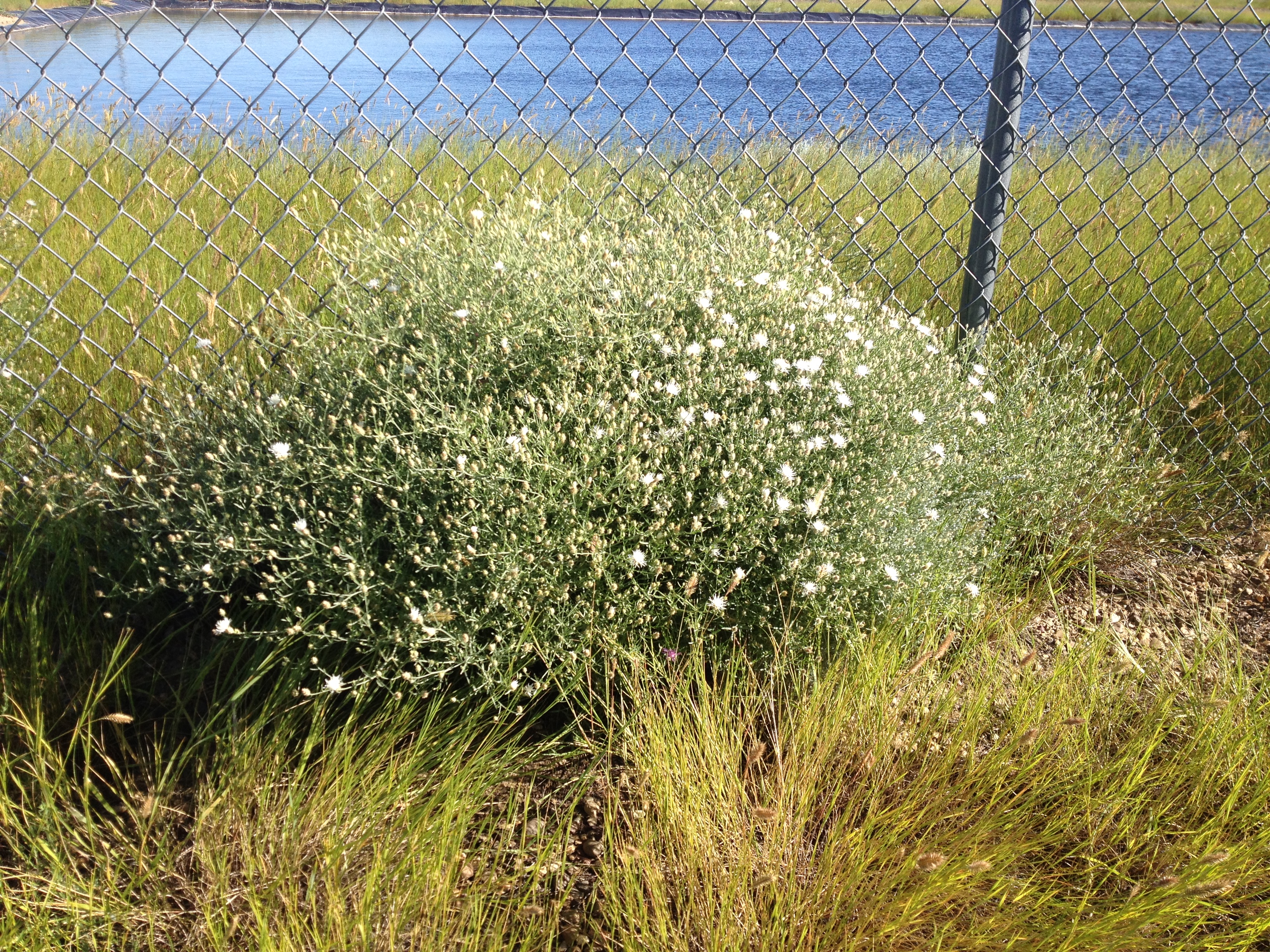
Field bindweed
Field bindweed (Convolvulus arvensis)
Field bindweed is a long-lived perennial vine that re-sprouts each year from its very extensive root system. Young plants develop a deep taproot, and then lateral roots which can extend 60m or more. Most of the root mass occupies the top 30 to 40 cm of the soil. It reproduces both by seed and vegetatively – new stems arise from buds on lateral roots. Typically vines climb and out-shade other plants. It can form dense mats in agricultural situations, smothering the crop and clogging harvesting machinery.
Field bindweed is recognized as a Noxious Weed under the Alberta Weed Control Act, meaning that “A person shall control a noxious weed that is on land the person owns or occupies.”
Field bindweed (Convolvulus arvensis)
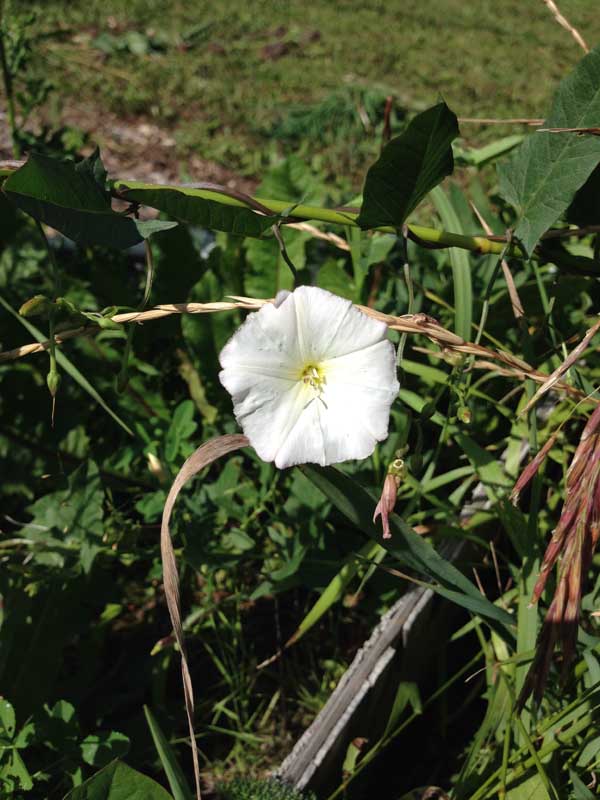 Alberta Weed Act Status: Noxious Weed
Alberta Weed Act Status: Noxious Weed
Distinguishing features:
- Stems are twisted, twinning, and grow to 3 m more in length. They can be climbing or prostrate and form dense mats.
- Leaves are arrowhead shaped, smooth or finely hairy.
- Flowers are funnel-shaped, about 2.5 cm wide, can be white or pink.
Habitat preferences:
- Field bindweed has a broad range of habitat tolerances; dry to moist soils, is drought tolerant, and does well in clay type soils.
- It is not shade tolerant so it must climb to receive sunlight.
Control:
- Field bindweed is not palatable but may be consumed in severely overgrazed pastures. Hay contaminated with large amounts of field bindweed can cause colic in horses.
- Cultivation is only effective when repeated multiple times throughout the growing season for a few successive years.
- Mowing is not effective. Repeated hand-pulling may control small infestations of young plants.
https://abinvasives.ca/fact-sheet/field-bindweed/
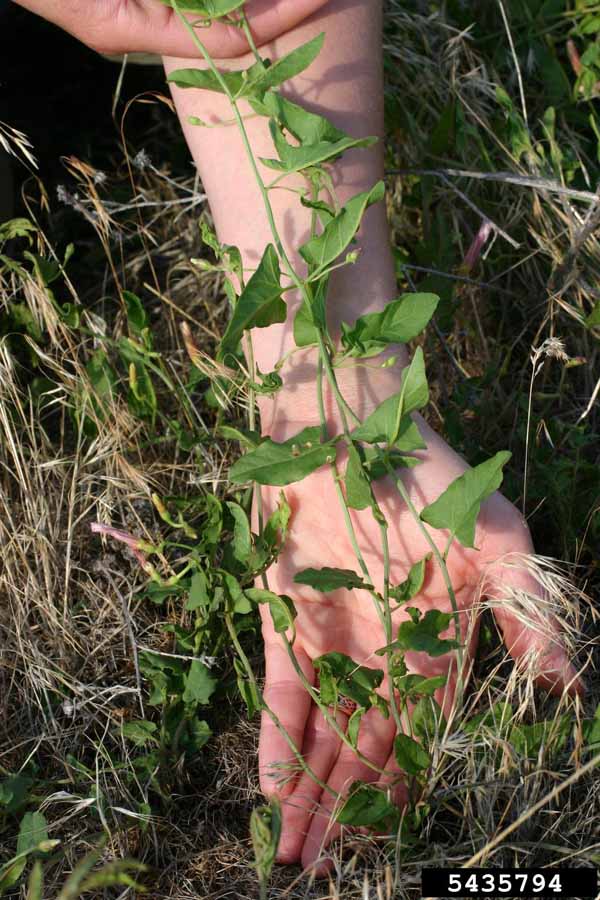
Flowering rush
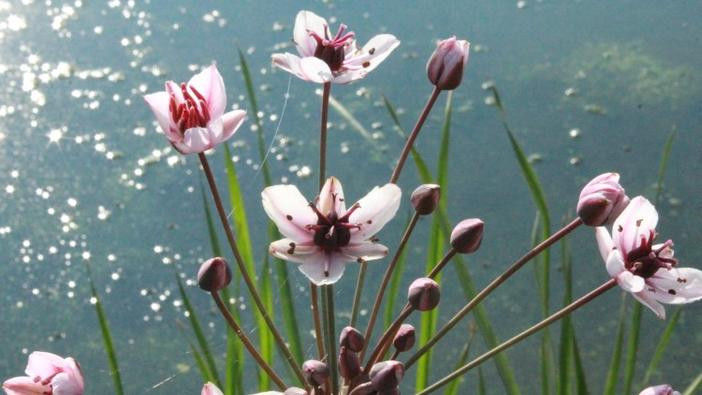
Hoary cress
Hoary cress (3 Species)
Hoary cress is a long-lived perennial of the mustard family. It develops an extensive system of deep, vertical taproots and horizontal, rhizomatous roots. It reproduces both by seed and sprouting from lateral roots – one plant can produce a large colony. Mustards are prolific seed producers – 1000-4000 per plant – however the viability of Hoary cress seeds is only about 3 years.
Native to Europe and Asia it is believed that Hoary Cress was introduced to North America in the 1800’s via seed contaminated crop seed. The seeds have been used to make pepper, hence the common name of “pepperweed.”
Hoary cress is recognized as a Noxious Weed under the Alberta Weed Control Act, meaning that “ A person shall control a noxious weed that is on land the person owns or occupies.”
Hoary cress (3 Species)
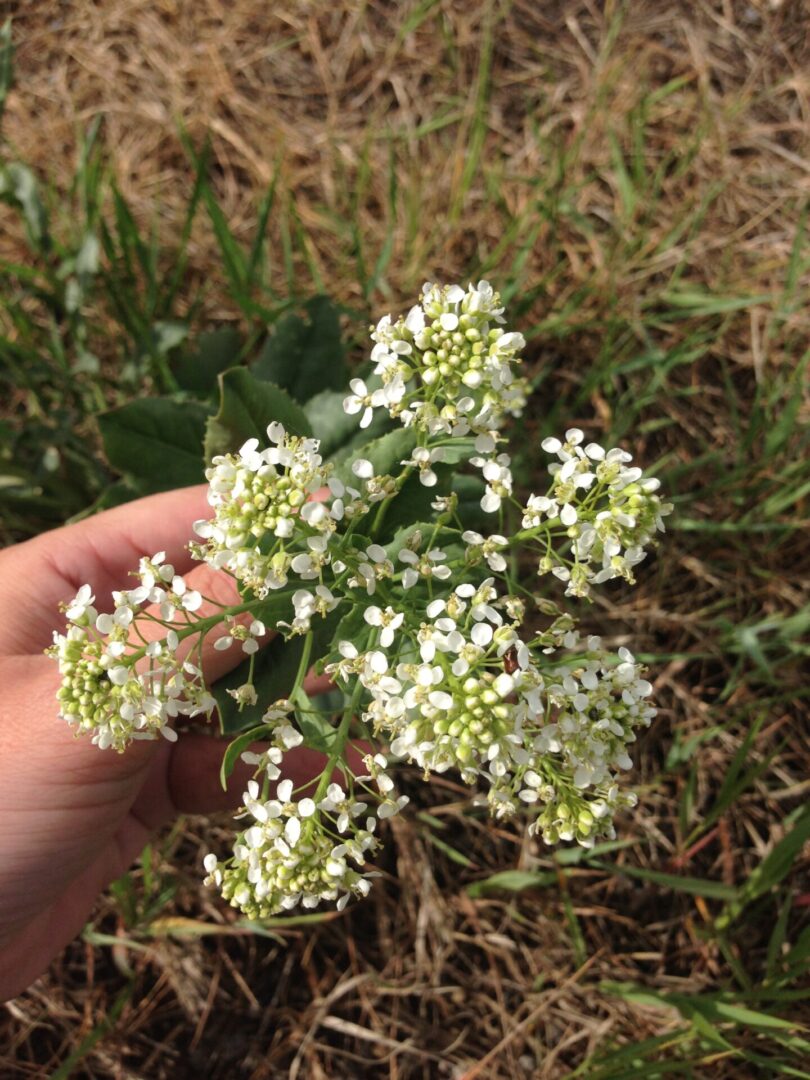 Globe-Podded (Lepidium appelianum)
Globe-Podded (Lepidium appelianum)
Heart-Podded (Lepidium draba)
Lens-Podded (Lepidium chalepense)
The 3 species listed above can be differentiated by the shape of the seed capsule.
Distinguishing features:
- Stems are erect, slightly hairy and can grow up to 0.6 m tall. There may be several stems per plant.
- Leaves are gray-green or blue-green, arrow-shaped, 5-10 cm long, alternate and covered with soft, white hairs.
- Flowers are white, about 3-4 mm wide, and have 4 petals. Numerous flowers are borne at the ends of stems in flat topped clusters. Flowering takes place early summer and they are pollinated by insects.
Habitat preferences:
- Hoary Cress requires full sun and moderately moist to slightly dry soils. It will tolerate alkaline soils.
Control:
- Grazing: Hoary cress is unpalatable to grazers.
- Cultivation: Tillage can be very effective but must begin early in the season and be repeated every 10 days. Sow and fertilize competitive grasses/legumes.
- Mechanical: Repeated mowing will prevent seed production and limit the spread but the plants will re-sprout.
https://abinvasives.ca/fact-sheet/hoary-cress/
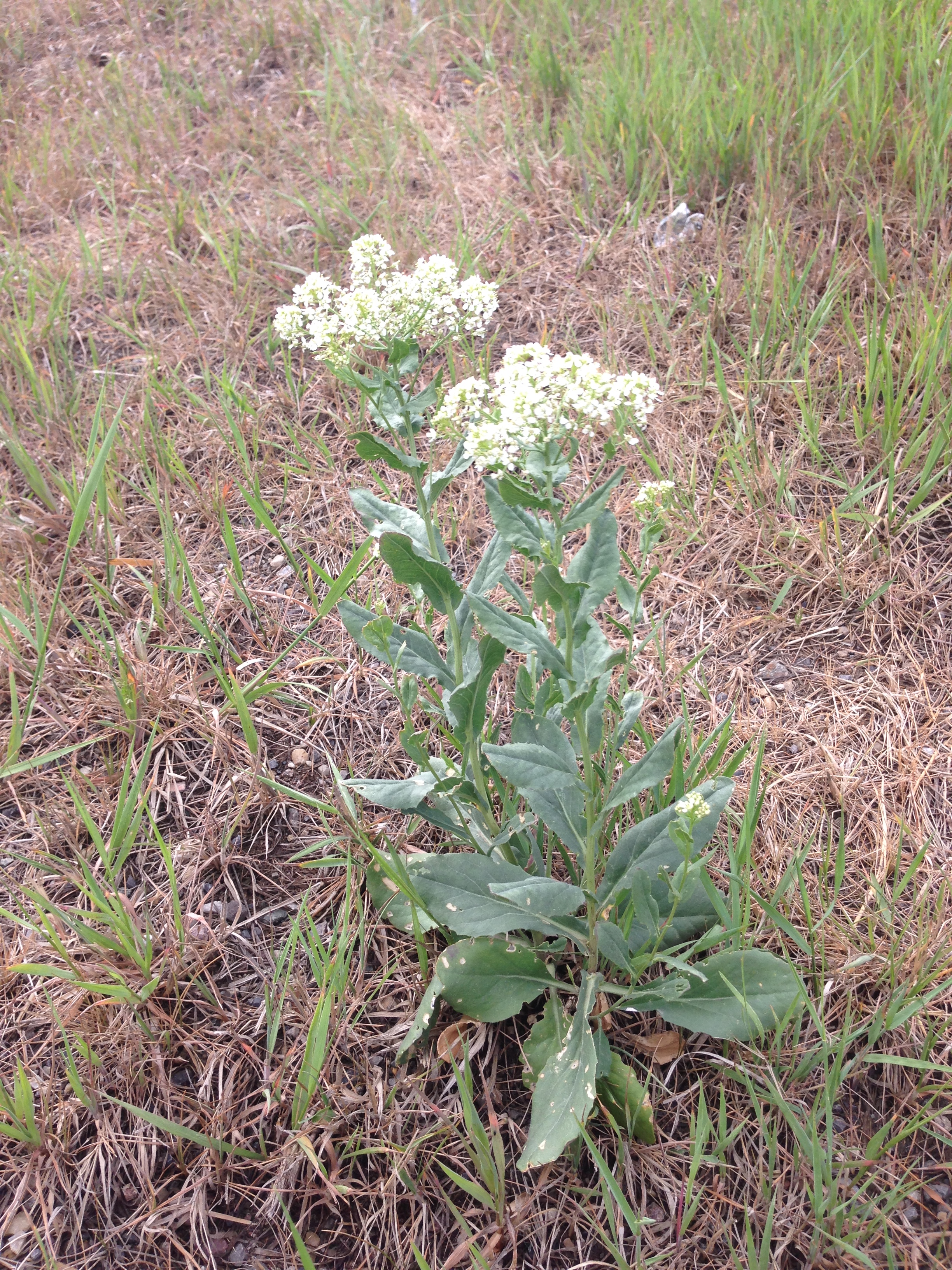
Hound's tongue
Hound’s tongue (Cynoglossum officinale)
This biennial plant produces a rosette in the first year of growth and a flowering bolt in the second year. It produces a woody taproot and reproduces by seed only. Fresh and dried plant matter contains toxic alkaloids that cause irreversible liver damage. Native to Eurasia, Hound’s tongue arrived as a contaminant of crop seed. All parts of the plant are covered with bristly hairs. The plant’s name comes from the resemblance of the leaf’s shape and roughness to a dog’s tongue.
Non-flowering plats can be confused with stickseed (Lappula genus) – stickseeds have spines on seeds rather than hooked burs. Two native plant diseases will cause brown spots or mildew but not enough to kill the plants.
Hound’s tongue is recognized as a Noxious Weed under the Alberta Weed Control Act, meaning that “A person shall control a noxious weed that is on land the person owns or occupies.”
Hound’s tongue (Cynoglossum officinale)
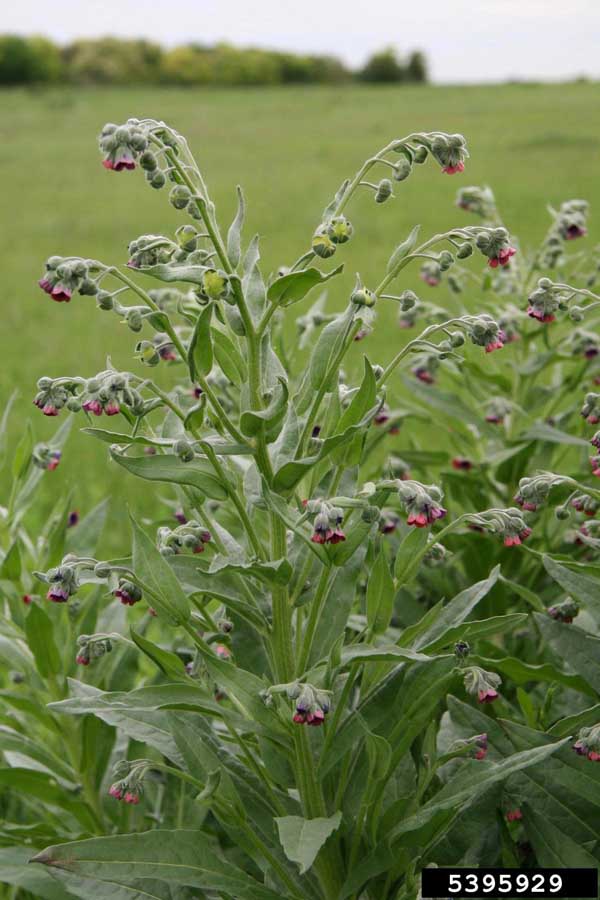 Alberta Weed Act Status: Noxious Weed
Alberta Weed Act Status: Noxious Weed
Distinguishing features:
- Stems are erect and usually branched in the upper portion, growing up to 1.5 m tall. There may be one or several stems per plant.
- Flowers are reddish purple, have 5 petals and hang in small clusters from panicles that originate in the leaf axils.
- Each flower produces 4 barbed nutlets, each about 7 mm long. Seeds usually remain on the plant until disturbed. Seeds are viable up to 3 years on the plant and about 1 year if buried.
Habitat preferences:
- Prefers drier, well-drained sites, but is tolerant of alkaline soils. Hound’s Tongue can grow under both deciduous and coniferous forest canopy.
Control:
- Grazing: While the growing plant is unpalatable to grazers, hound’s tongue in cured hay is readily consumed and poisonous to cattle and horses: sheep seem to be less affected. The toxic alkaloids stop liver cells from reproducing and animals may live for 6 months or more after consuming a lethal dose. There is no medical recourse. Heavily burred cattle and sheep suffer physical stress and are devalued at market. Hound’s tongue infested rangeland is a self-reinforcing spiral that destroys forage resources for both wildlife and livestock.
- Cultivation: Repeated cultivation is effective in cropland situations.
https://abinvasives.ca/fact-sheet/hounds-tongue/
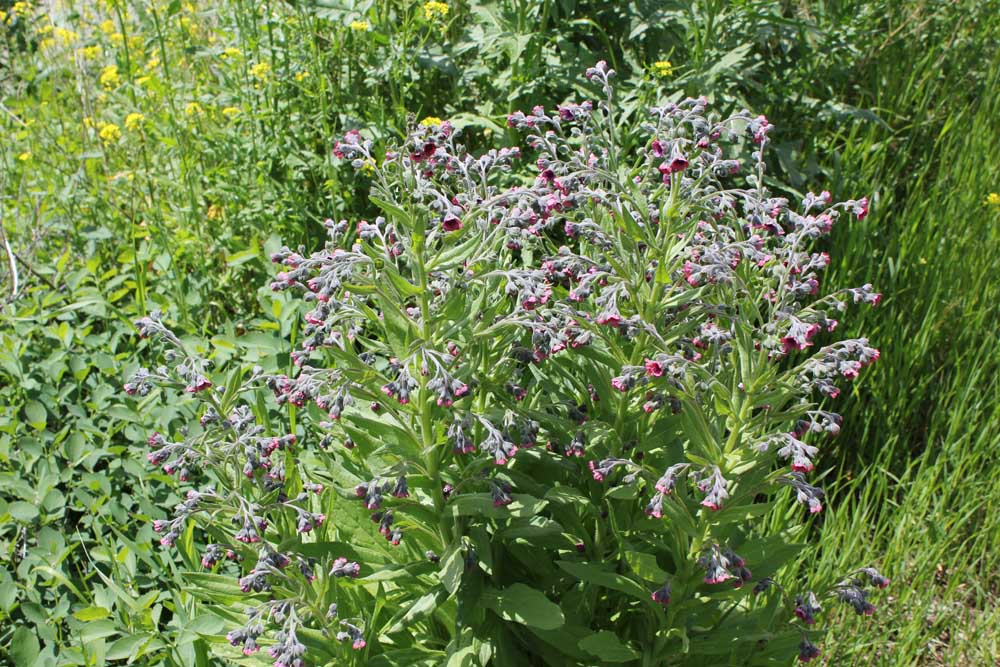
Leafy spurge
Leafy Spurge (Euphorbia esula)
Leafy spurge is a long-lived perennial that was introduced as either an ornamental or crop seed contaminant in the early 1800’s. It reproduces primarily by re-sprouting from its extensive, persistent, creeping root system, but also by seed. Leafy spurge roots can extend 4.5 m laterally and about 9 m deep. Leafy spurge forms dense stands over times and a large plant can produce up to 130,000 seeds. All parts of the plant contain a milky-coloured latex that can poison livestock and cause skin irritation on humans.
Leafy Spurge is recognized as a Noxious Weed under the Alberta Weed Control Act, meaning that “A person shall control a noxious weed that is on land the person owns or occupies”
Leafy Spurge (Euphorbia esula)
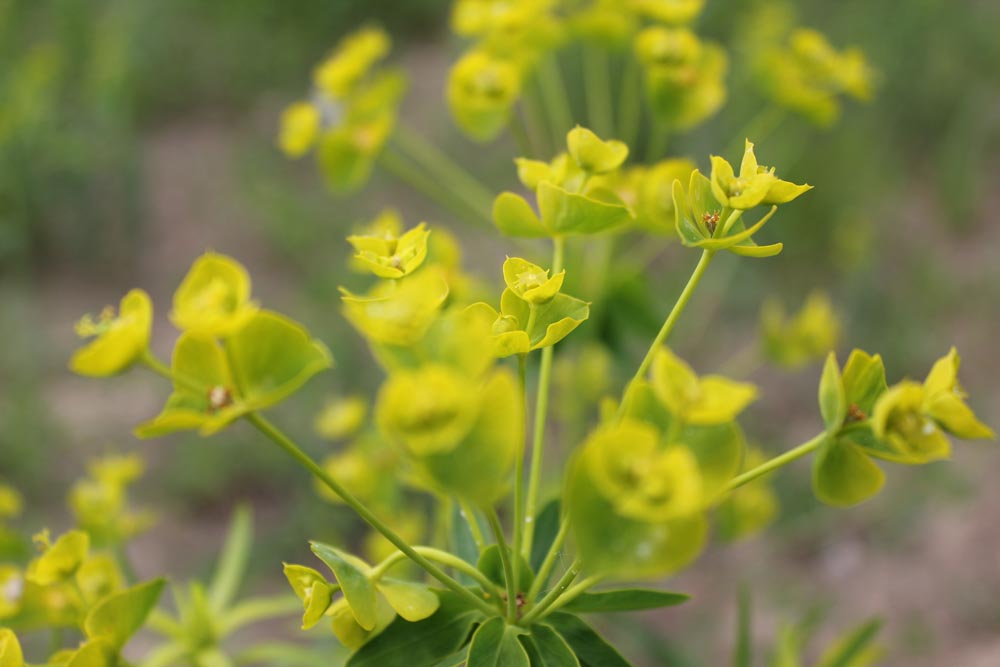 Alberta Weed Act Status: Noxious Weed
Alberta Weed Act Status: Noxious Weed
Distinguishing Features:
- Flowers are small, yellowish-green, lack petals and sepals, and are supported by 2 green, heart-shaped, leaf-like bracts.
- Stems are arranged in clumps, smooth and hairless, grow up to 1 meter tall and contain a milky latex.
Habitat Preferences:
- Adapted to a wide variety of site conditions. It grows on a range of soil types and tolerates very dry to very wet climates; but does require warmth for growth.
Control:
- Grazing: Sheep and goats will readily graze leafy spurge and are not affected by the toxic juices in the stems.
- Mechanical: Hand-pulling and mowing is ineffective other than on small, young infestations. Wear gloves and wash hands after handling leafy spurge to avoid skin rashes.
- Biological: 5 flea beetles and 2 moths have been imported for biocontrol on leafy spurge.
https://abinvasives.ca/fact-sheet/leafy-spurge/

Nodding thistle
Nodding thistle (Carduus nutans)
Biennial or winter annual that reproduces by seed only. A native of Europe, nodding thistle has a long history as a rangeland pest. The invasive nature of this aggressive plant can lead to severe degradation of native grasslands and meadows because grazing animals focus on native vegetation giving the thistles a competitive advantage. It develops a long, fleshy taproot that becomes corky & hollow near the crown. Rosettes can be quite large.
Nodding thistle is recognized as a Prohibited Noxious Weed under the Alberta Weed Control Act, meaning that “A person shall destroy a prohibited noxious weed that is on land the person owns or occupies.”
Nodding Thistle (Carduus nutans)
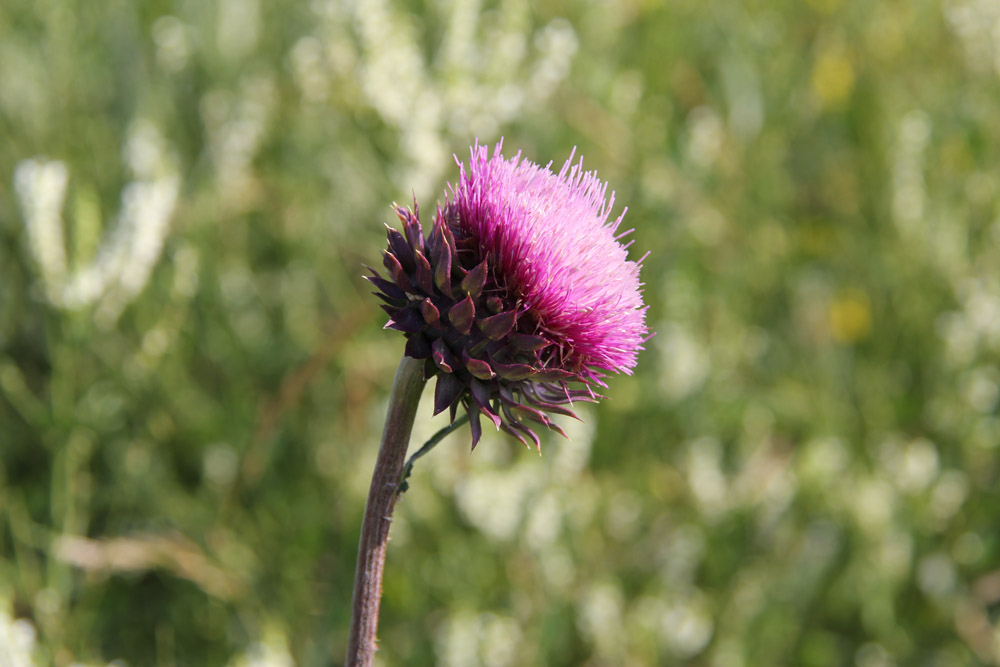 Alberta Weed Act Status: Prohibited Noxious
Alberta Weed Act Status: Prohibited Noxious
Distinguishing features:
- Flower heads are solitary at the ends of stems, about 3-5cm in diameter and are composed of hundreds of tiny reddish-purple flowers.
- Flower heads commonly droop when mature, hence the name “Nodding Thistle”.
- First year forms a large rosette; second year grows between 20 cm up to 2.5 m tall.
Habitat preferences:
- Nodding thistle grows from sea level to about 8,000 ft elevation, in neutral to acidic soils. It prefers disturbed areas but is still able to invade healthy plant communities. Nodding thistle can form tall, impenetrable thickets. It is not tolerant of excessively wet, dry, or shady conditions.
Control:
- Grazing: not grazed by cattle, however young plants may be grazed by sheep and goats.
- Mechanical: Hand-digging or mowing can provide control if repeated over several years. Mowing just before seed set is effective, but the debris should be collected and burned.
https://abinvasives.ca/fact-sheet/thistle-nodding/

Oxeye daisy
Oxeye daisy (Leucanthemum vulgare)
Oxeye daisy and the very similarly flowered Scentless chamomile can be considered conspicuous, as there are no native white flowered daisies in Alberta. Often perceived to be a “pretty” wildflower, this non-native is an aggressive invader. Oxeye daisy is a perennial that spreads primarily by seed, but also shallow, creeping roots. Individual plants can producer over 500 seeds that are viable in the soil for 2-3 years or more.
The greatest impact of Oxeye daisy is on forage production in pastures and meadows. Cattle avoid Oxeye daisy and therefore any pasture infested with dense stands of Oxeye daisy will decrease forage available for grazing. Dense strands of Oxeye daisy can decrease plant diversity and increase the amount of bare soil in the area.
Oxeye daisy is recognized as a Noxious Weed under the Alberta Weed Control Act, meaning that “A person shall control a noxious weed that is on land the person owns or occupies.”
Oxeye daisy (Leucanthemum vulgare)
 Alberta Weed Act Status: Noxious Weed
Alberta Weed Act Status: Noxious Weed
Distinguishing features:
- Leaves progressively decrease in size upward on the stem. Basal and lower leaves are lance-shaped with “toothed” margins and petioles that may be as long as the leaves. The upper leaves are alternately arranged, narrow and clasp the stem with wavy margins.
- Flowers are borne slightly at the end of stems and can be up to 5 cm in diameter with yellow centers, and 20-30 white petals radiating from the center. The petals are slightly notched at the tip.
Habitat preferences:
- Oxeye daisy grows in a wide variety of habitats and flourished in nutrient poor soils.
Control:
- Grazing: Oxeye daisy is avoided by cattle and therefore capable of dominating pastures and rangeland. Horses, sheep and goats will readily graze Oxeye daisy and can be used in companion grazing situations to control Oxeye Daisy.
- Mechanical: Repeated mowing prevents seed production, but also can stimulate re-sprouting of stems. Hand-pulling or digging before seed production is effective but it is important to remove as much of the stem as possible.
https://abinvasives.ca/fact-sheet/oxeye-daisy/
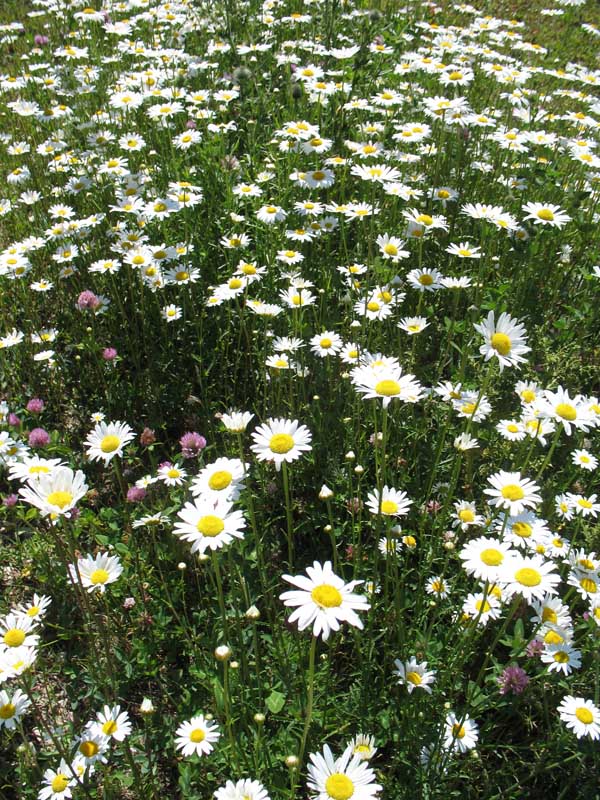
Puncturevine
Puncturevine (Tribulus terrestris)
Puncturevine is a summer annual (perennial in warm climates) herb native to the hot, dry climates of southern Europe. The suspected method of introduction is in the wool of sheep imported from the Mediterranean somewhere around 1900, Puncturevine grows very low to the ground forming dense mats 0.5-1.5 m in diameter. The stems radiate out from the root. It grows a very deep taproot (2 m or more). It is also a very efficient user of water, allowing it to survive drought. Above ground plant parts are killed by frost, but it can re-sprout from the root.
Flowering begins within 2-5 weeks of emergence and can continue for several months. Fruits form about 2 weeks after flowering. These fruits/burrs mature in another 2 weeks before splitting into 4 or 5 segments. Each segment is armed with spines arranged so that at least one is pointing upwards when lying on the soil surface. These spines are strong enough to penetrate bicycle tires. A typical plant can produce 200-500 seeds per growing season. Puncturevine’s burrs can puncture the feet of livestock, causing suffering, infection, and lameness, especially in horses.
Puncturevine is recognized as a Prohibited Noxious Weed under the Alberta Weed Control Act, meaning that “A person shall destroy a prohibited noxious weed that is on land the person owns or occupies”
Puncturevine (Tribulus terrestris)
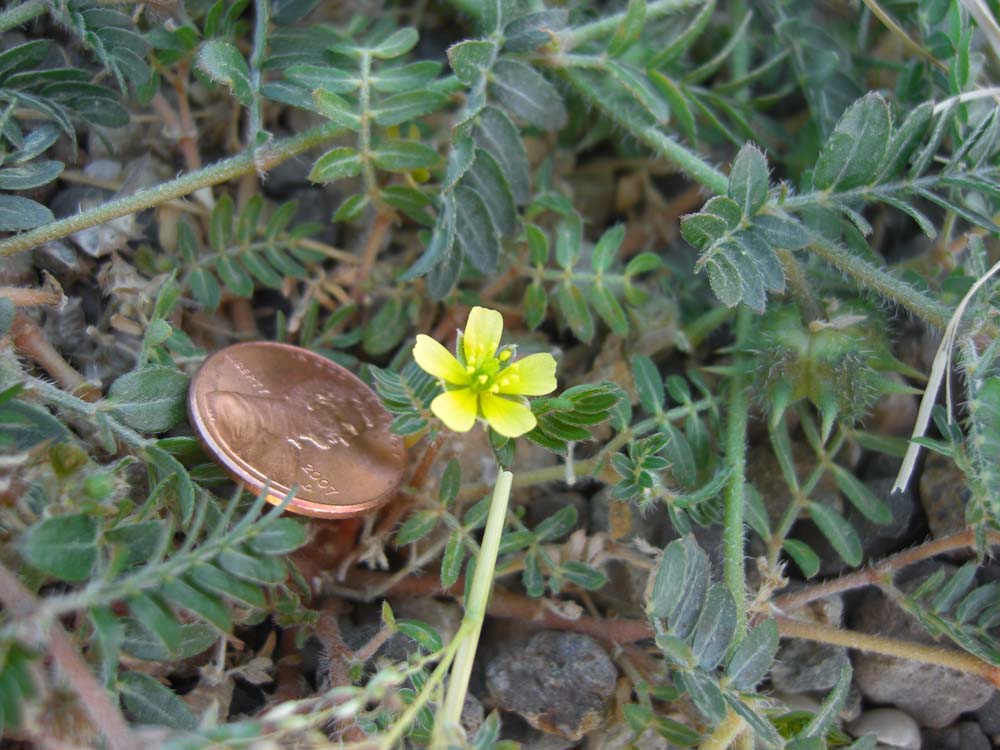 Distinguishing features:
Distinguishing features:
- Stems are greenish-red, up to 2 m long with branches 20-60 cm long. Stems can be smooth, finely hairy or covered with coarse, firm hairs.
- Leaves are opposite, even pinnate, 1.5-5 cm long with 6-16 leaflets. Leaflet blades are oblong.
- Flowers are yellow, 5 petals, 7-11 mm in diameter, and borne singly on short stalks in the axils of the smaller of each pair of leaves. They open in the morning and close or shed their petals in the afternoon.
Habitat preferences:
- Puncturevine grows on almost any soil type, but grows best in dry, loose, sandy soils, and dunes or loose blown soils around field margins. It also grows in heavier, compact soils which are moist.
Control:
- Grazing: The sharp spines of the burr cause mouth and intestinal injuries to grazers. It is toxic to sheep, causing light sensitivity which leads to skin lesions, swelling and eventual necrosis of skin, lips, ears, and even death in young animals. Puncturevine can also cause nitrate poisoning in both cattle and sheep.
- Mechanical: Repeated, shallow cultivation before seed production, which severs the taproot can be effective.
https://abinvasives.ca/fact-sheet/puncturevine/
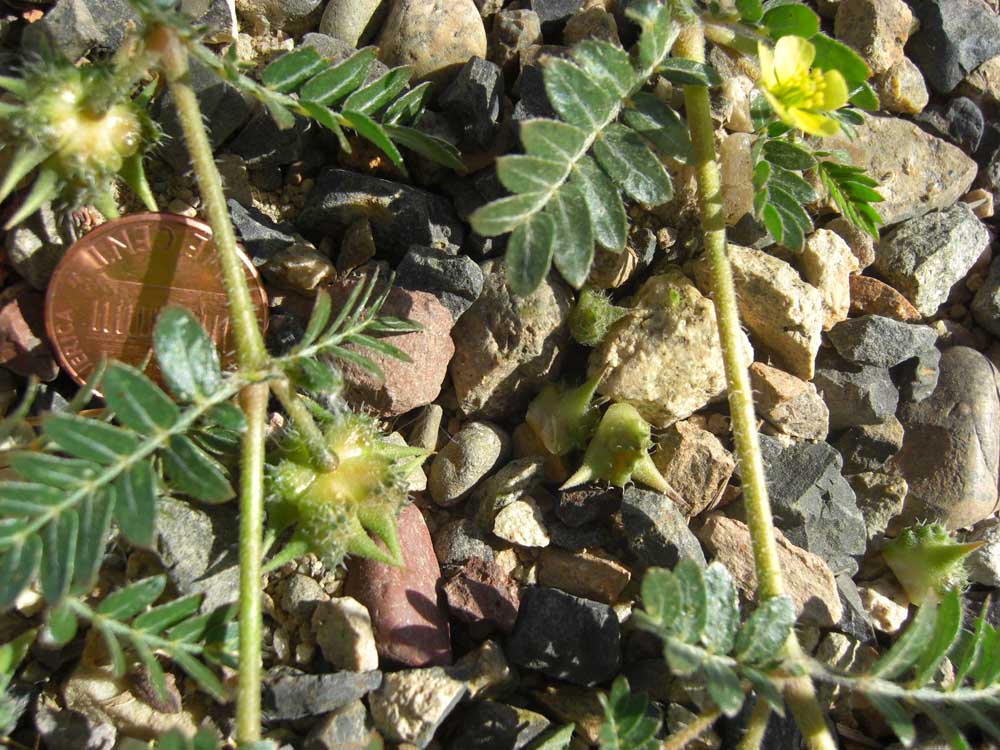
Russian knapweed
Russian knapweed (Rhaponticum repens)
Russian knapweed is a long-lived perennial that produces seed but reproduces primarily by sprouting buds from its spreading root system. Roots are black or dark brown with small, alternate scales – buds sprout from within the scale axils. This sprouting results in dense, cloned patches of plants. Rosettes form in the spring and plants bolt early summer. The roots also exude a substance that inhibits the growth of nearby plants. Russian knapweed contains toxic compounds that can cause “chewing disease” in horses, a neurological disorder. Horses must consume large quantities – more than 50% of its body weight in about 30 days. Only horses are affected, and it is fatal once symptoms develop.
Russian knapweed is recognized as a Prohibited Noxious Weed under the Alberta Weed Control Act, meaning that “A person shall destroy a prohibited noxious weed that is on land the person owns or occupies.”
Russian knapweed (Rhaponticum repens)
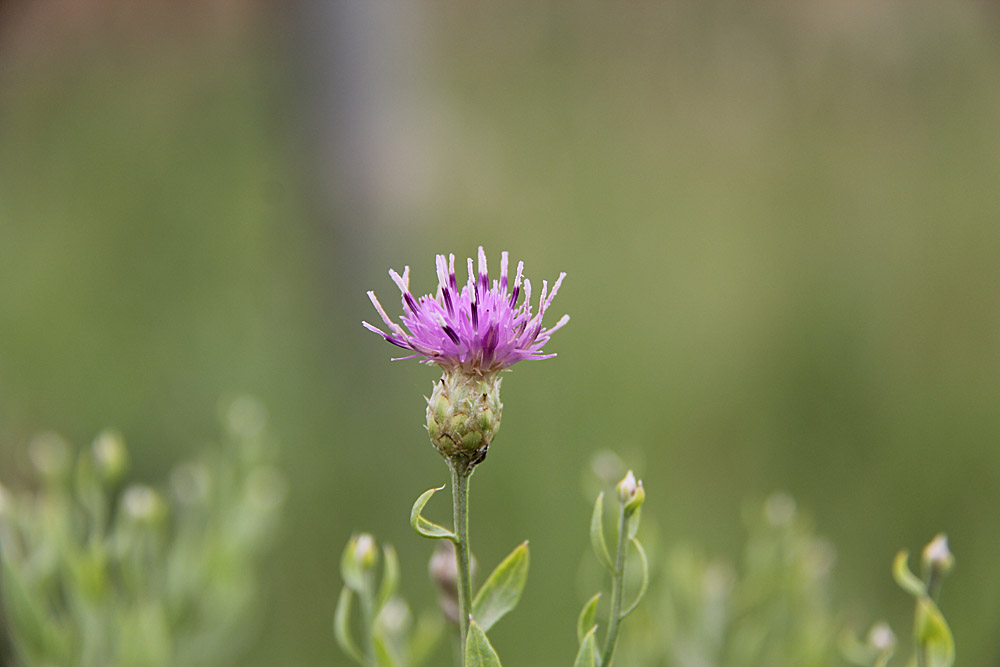 Alberta Weed Act Status: Prohibited Noxious Weed
Alberta Weed Act Status: Prohibited Noxious Weed
Distinguishing features:
- Flowers are urn-shaped, pink to purple flowers that occur singly at the ends of stems.
- Stems are erect, thin, stiff and branched openly; they can be from 0.5 to 1 m tall. Young stems are covered with soft, short gray hairs.
Habitat preferences:
- Native to Eurasia, it thrives in any soil, but does very well in clay soil. It is intolerant of shade, prolonged drought, and wet sites.
Control:
- Grazing: Russian Knapweed is considered unpalatable unless suitable forage is lacking (overgrazing).
- Cultivation: Cultivation without herbicide use is more likely to spread infestations by distributing root pieces.
- Mechanical: Removal of the plant to ground level prevents seed production. Repeated removal can help exhaust root reserves.
- Biological: The biological control agent that has received the most study is the Russian knapweed gall nematode (Subanguina picridis). Larval and adult stages of the nematode form galls on plant stems, leaves and root crowns. Infective larvae form galls in the spring and multiply until August; the larvae then disperse into the soil until the next year.
https://abinvasives.ca/fact-sheet/knapweed-russian/
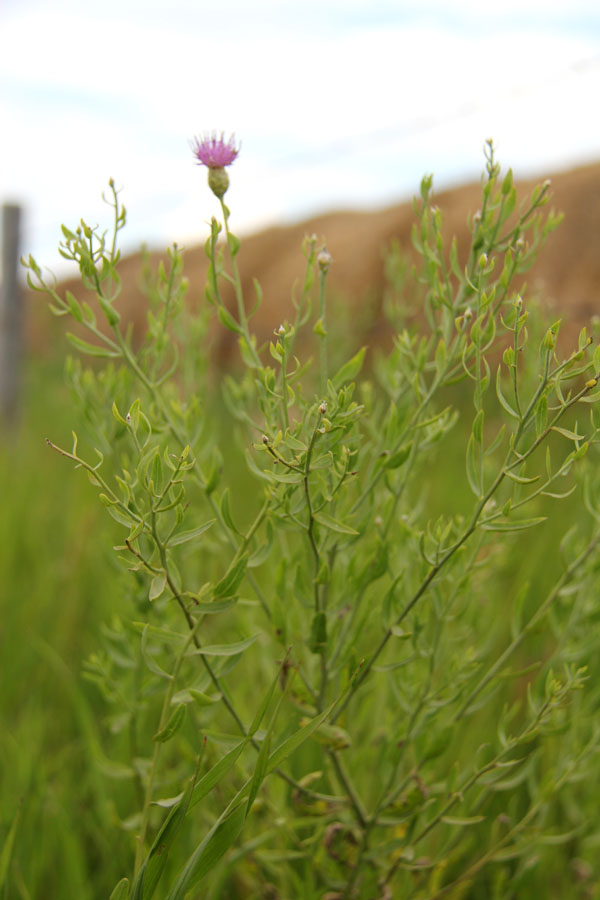
Scentless chamomile
Scentless chamomile (Tripleurospermum inodorum)
Scentless chamomile can behave as an annual, biennial, or sometimes a perennial, but reproduces by seed only. Plants are usually very bushy and have a fibrous root system. It continually blooms, forms seed, and seeds germinate throughout the growing season: fall seedlings overwinter and are usually first to flower in spring. Native to Europe, it was introduced as an ornamental and/or a contaminant in crop seed. This is not the chamomile used for tea as it is scent-less. A single, robust plant can occupy one full square metre and produce up to one million seeds. Scentless chamomile and Oxeye daisy are often mistaken for each other as the flowers are nearly identical, but the leaves are very different. Both plants are weeds - there are no native white-flowered daisies in Alberta. It can also be confused with stinking mayweed or pineapple weed, but the foliage of these two plants has an odour.
Scentless chamomile is recognized as a Noxious Weed under the Alberta Weed Control Act, meaning that “a person shall control a noxious weed that is on land that the person owns or occupies.”
Cypress County has elevated Scentless chamomile, as a Prohibited Noxious weed under Cypress County Policy.
Scentless chamomile (Tripleurospermum inodorum)
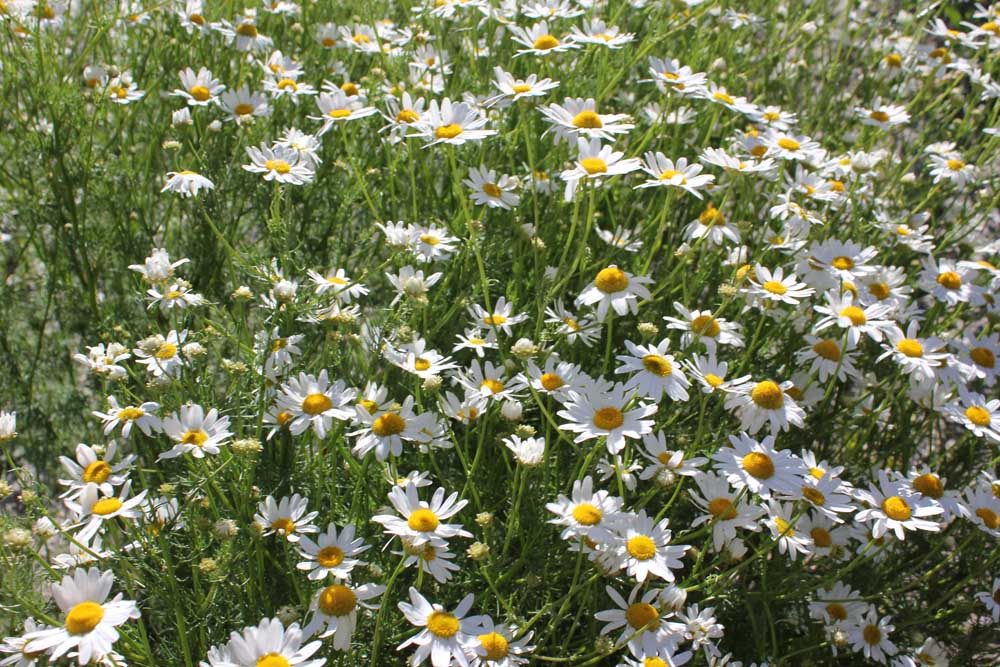 Alberta Weed Act Status: Noxious Weed
Alberta Weed Act Status: Noxious Weed
Distinguishing features:
- Stems are erect to semi-erect, highly branched, may be reddish in color, and can grow up to 1 m tall. There can be a few to many stems per plant.
- Leaves are alternate and very finely divided into short segments (carrot-like) and odorless when crushed.
- Flowers are composed of a yellow central disc surrounded by white petals. The flowers are borne singly at the end of stems and have numerous bracts, arranged in overlapping rows.
Habitat preferences:
- Scentless Chamomile is well adapted to heavy clay soils and tolerates both periodic flooding and dry sites. It is a poor competitor but establishes quickly on disturbed sites. The seeds float on water and are widely dispersed this way.
Control:
- Grazing: Scentless Chamomile is generally unpalatable to grazers and its seeds can survive digestion. Invasive plants should never be considered as forage.
- Cultivation: Late fall and early spring tillage will control rosettes. Frequent, shallow tillage can help exhaust the seed bank by repeatedly destroying germinating seedlings.
- Mechanical: Mowing can prevent seed production but plants will re-bloom below the cutting height. Hand-pulling can prevent spread into new areas and is effective on small infestations.
https://abinvasives.ca/fact-sheet/scentless-chamomile/
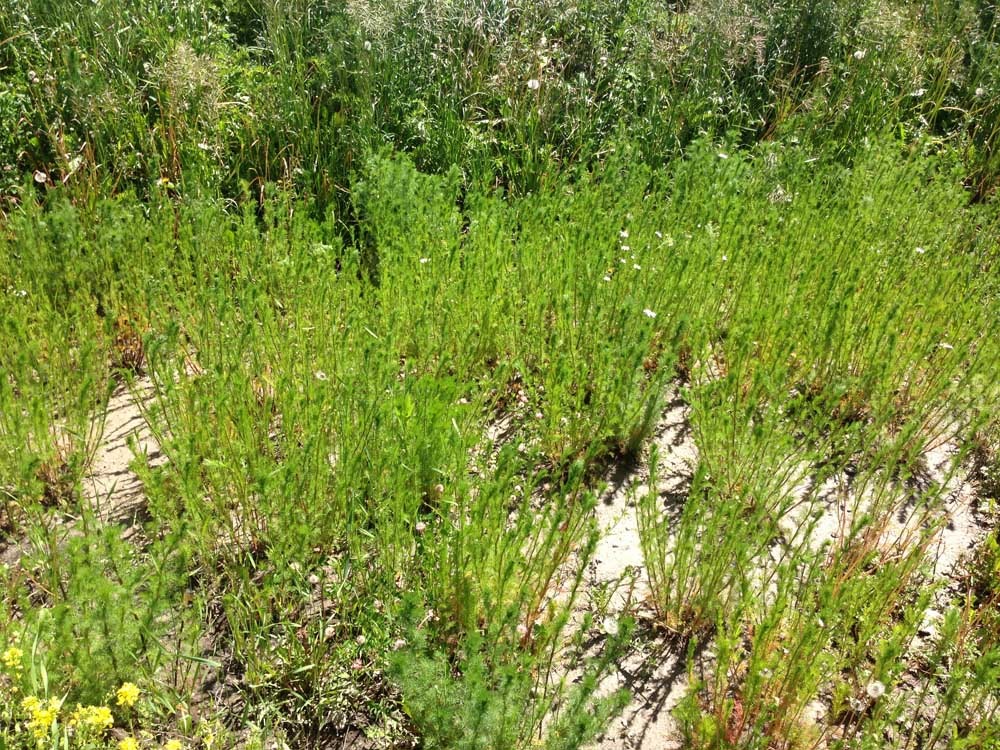
Spotted knapweed
Spotted knapweed (Centaurea stoebe)
Primarily a biennial plant – producing a rosette the first year and a flowering bolt the second – but can also be a short-lived perennial, blooming for a few years before dying. Spotted knapweed can self-pollinate and is also cross-pollinated by insects. A prolific seed producer – individual plants can produce over 140,000 per year – control is extremely difficult on established infestations. Knapweeds have become well known because of their almost wholesale degradation of large tracts of rangeland in the northwestern US and parts of southern BC. Knapweed contaminated hay or plant skeletons caught in vehicle undercarriages often contribute to spread. In winter plant skeletons break off and tumble in the wind, spreading seed. Spotted knapweed roots exude a chemical that inhibits the root growth of other plants.
Spotted knapweed is recognized as a Prohibited Noxious Weed under the Alberta Weed Control Act, meaning that “A person shall destroy a prohibited noxious weed that is on land the person owns or occupies.”
Spotted knapweed (Centaurea stoebe)
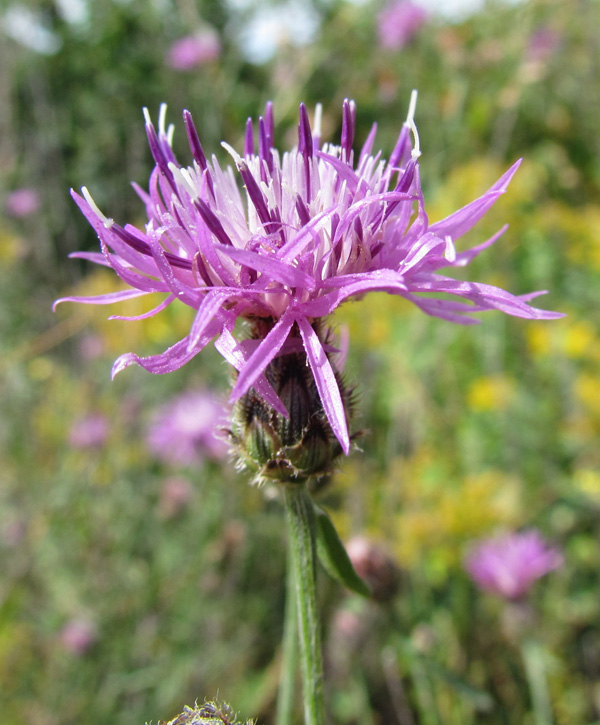 Alberta Weed Act Status: Prohibited Noxious
Alberta Weed Act Status: Prohibited Noxious
Distinguishing features:
- Stems are upright and branched, growing up to 1.5m tall. There may be one or a few stems per plant.
- Flowers are borne singly at the ends of branches. The flowers are pinkish-purple, can occasionally be creamy white. Bracts on the flower’s base have black tips, distinguishing it from other knapweed species.
Habitat preferences:
- Native to Eastern Europe, spotted knapweed is commonly found on well-drained, light to coarse textured soils, but is intolerant of dense shade.
- Infesta6tions often form monocultures and can even extend into relatively undisturbed plant communities, displacing forage for wildlife and livestock.
Control:
- Knapweed seeds have an extremely hard seed coat and can be viable for at least 5-10 years. Therefore, knapweed control sites will need to be revisited for many years.
- Mechanical: Cutting or pulling before flowering can be effective on small infestations to prevent seed production, but will require several years’ effort to eradicate.
https://abinvasives.ca/fact-sheet/knapweed-spotted/
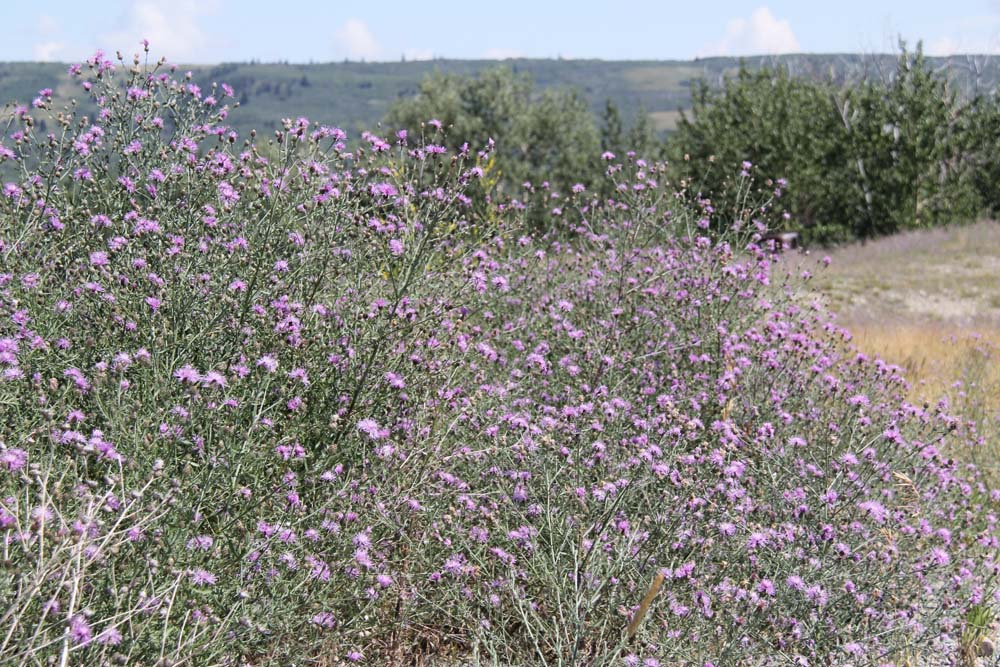
White cockle
White cockle (Lychnis alba syn. Silene alba S. latifolia)
White cockle was introduced from Eurasia and is often confused with bladder campion (not hairy, not sticky) or night-flowering catchfly (hairy, upper stems sticky), white cockle is not sticky on any part of the plant. It is a short-lived perennial (sometimes biennial) native to Europe. Plants are either male or female, so not all plants produce seed.
Flowers are numerous, fragrant and arranged in spreading clusters. The white (or pinkish) flowers have 5 notched petals and only open in the evening. The tubular calyx surrounds the flower’s base. The calyx of the male flower has 10 veins, and the female’s 20 veins are longer, and inflate with ripening.
White cockle (Lychnis alba syn. Silene alba S. latifolia)
 Distinguishing features:
Distinguishing features:
- Stems are hairy, grow 30 to 120cm tall, and can be erect or spread laterally. There can be several stems per plant – crowded plants branch in the upper stems. Stems are swollen at the nodes.
- Leaves are opposite, hairy, and lance or slightly oval-shaped with pointed tips. Basal leaves and upper stem leaves are smaller.
- Flowers are numerous, fragrant and arranged in spreading clusters. The white (or pinkish) flowers have 5 notched petals and only open in the evening. The tubular calyx surrounds the flower’s base. The calyx of the male flower has 10 veins, and the female’s 20 veins are longer, and inflate with ripening.
- The calyx matures into a fruit with 10 teeth at the tip containing many tiny, grayish seeds.
Habitat preferences:
White cockle prefers full-sun and rich, well drained soils. Hayfields are a frequent habitat of this invasive plant – compounding the problem as weed seed gets distributed in baled forage.
Control:
- White cockle can be a serious economic problem as its seeds are difficult to separate from alfalfa, clover and some grass crop seeds – and this invader is an extremely heavy seed producer. This plant emerges early spring, initially forms a taproot, and next spreading lateral roots.
- Grazing: Not grazed. Invasive plants should never be considered as forage.
- Cultivation: Stem and root pieces can sprout to form new plants; therefore cultivation will usually spread an infestation.
- Mechanical: Frequent mowing will reduce seed production.
- Chemical: Mecoprop (in a product mix with 2,4-D and Dicamba) and Tribenuron-methyl (alone or in a product mix with Metsulfuronmethyl and quinchlorac) are registered for use on white cockle.
https://abinvasives.ca/fact-sheet/white-cockle/
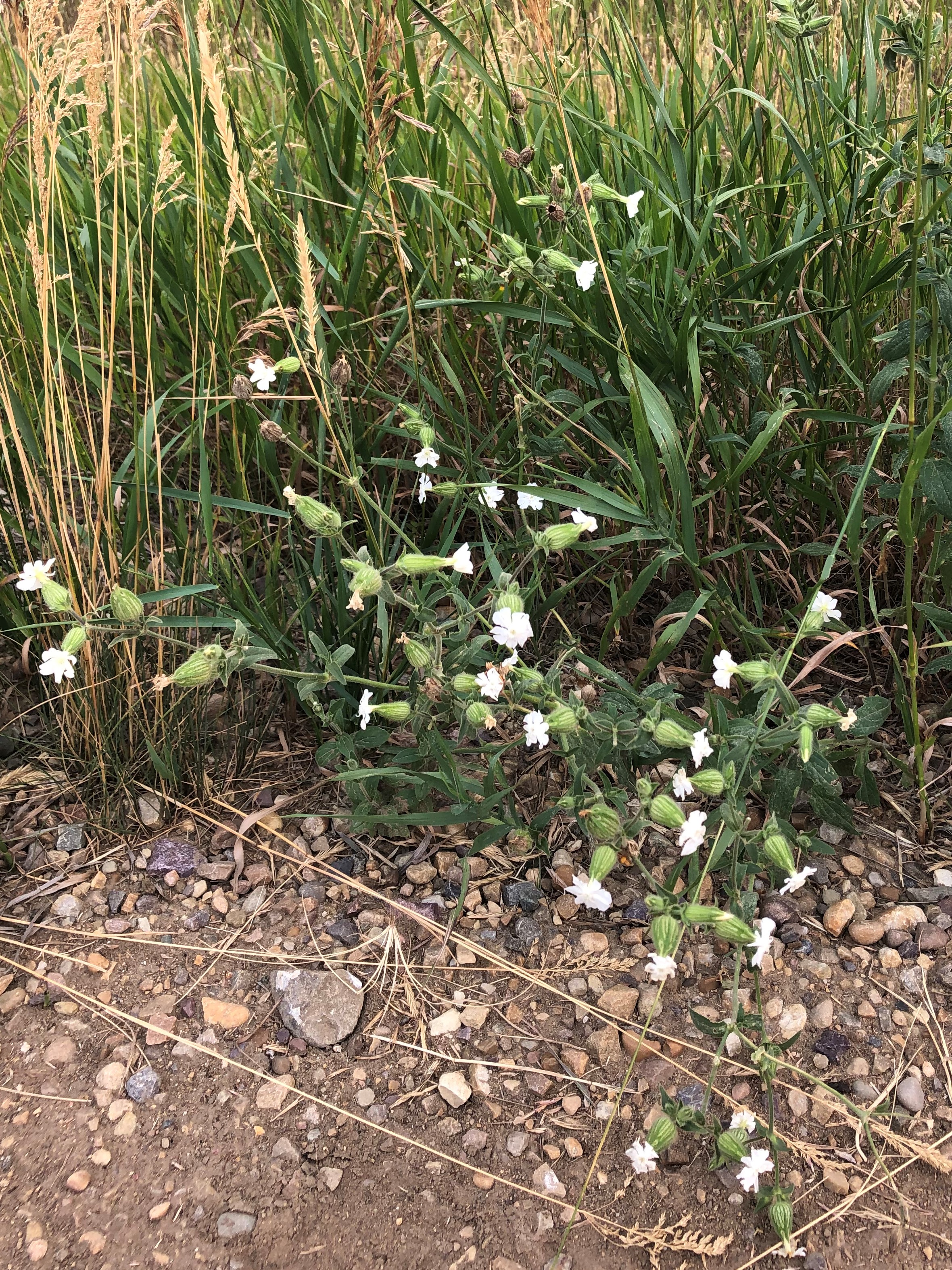
Yellow Flag Iris
Yellow Flag Iris (Iris pseudacorus)Recently found in Cypress County for the first time along Seven Persons Creek, Yellow Flag Iris is a prohibited noxious weed and must be destroyed. First introduced to North America in the 19th century as an ornamental plant, the iris thrives in wet areas such as ditches, canals, marshes and ponds. It will outcompete native species, is toxic, and extremely difficult to eradicate. Look for stems up to 1.5 metres tall, dark green leaves almost as tall, and tri-sepaled flowers 8-10 cm in diameter. Hand-pulling (with proper protection!) must be done with caution, as seeds are easily released. No chemicals are registered for use in Canada. Covering with heavy rubber matting can starve the plant over months. 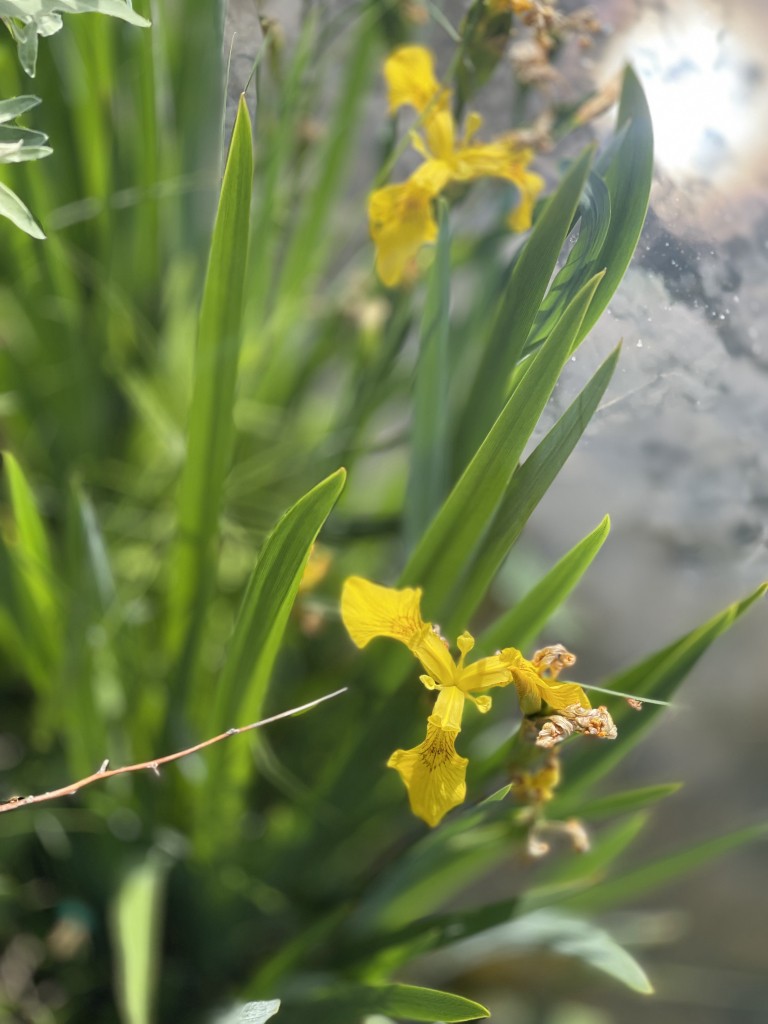 |
Yellow toadflax
Yellow toadflax (Linaria vulgaris)
Brought from Europe over 100 years ago as an ornamental plant, common toadflax has escaped and has now become a serious problem to rangeland and mountain meadows all over North America. This perennial plant makes seed, but reproduction is primarily by sprouting from its extensive, creeping root system (rhizomes) – 2–3-week-old seedlings can produce creeping roots. The ability of this plant to form large colonies allows it to crowd out other vegetation. Common toadflax is easily confused with Leafy spurge before flowering, but toadflax stems do not contain the milky latex that spurge does.
Yellow toadflax is recognized as a Noxious Weed under the Alberta Weed Control Act, meaning that “a person shall control a noxious weed that is on land the person owns or occupies.”
Yellow toadflax (Linaria vulgaris)
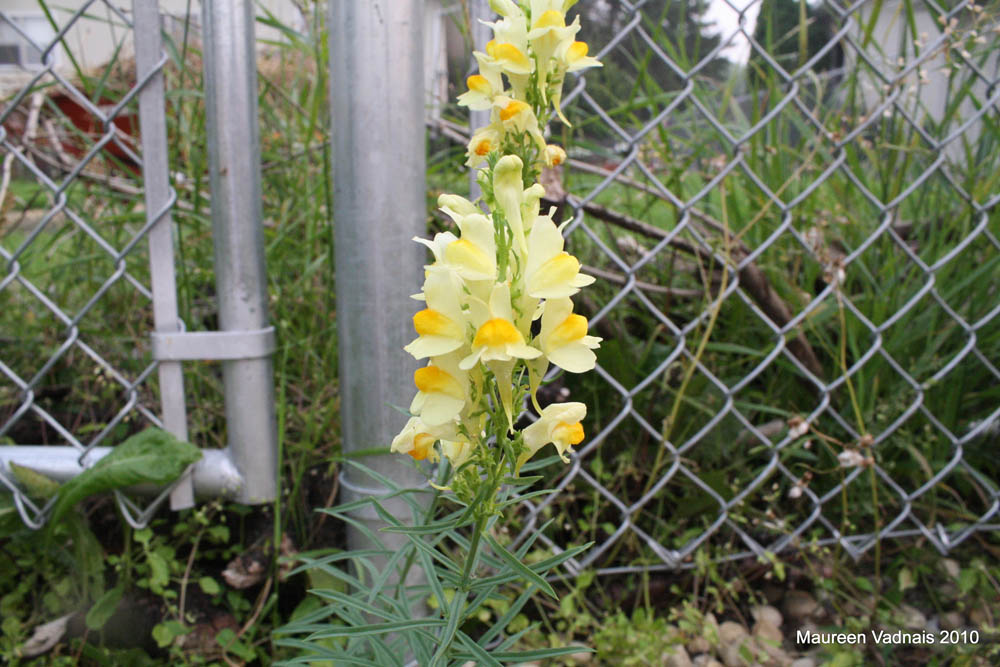 Alberta Weed Act Status: Noxious Weed
Alberta Weed Act Status: Noxious Weed
Distinguishing features:
- Stems are erect, hairless, generally un-branched and can be as short as 15cm or grow to 1 m tall. Mature plants may have 1 to 25 stems.
- Flowers are bright yellow, arranged alternately in dense spikes at the ends of stems and have a long spur extending from the base that is usually as long as the flower itself – in all, 2 to 3.5 cm long.
- The snapdragon-like flowers can have orange colouring on the throat. They flower at different times depending on site conditions.
- Leaves are soft, lance-shaped, pale green, and very numerous. Leaves are mainly alternate but may appear opposite on the lower stem due to crowding.
Habitat preferences:
- Native to nearly all parts of Europe and Asia, toadflax prefers sandy-gravely soils, but is adapted to a wide range of growing conditions.
Control:
- Grazing: Pasture invasions flourish because the plant is not palatable to livestock.
- Cultivation: Repeated cultivation can effectively destroy the root system.
- Mechanical: Thorough hand-pulling can be effective in soft soils where the roots can be removed easily.
https://abinvasives.ca/fact-sheet/toadflax-yellow/
